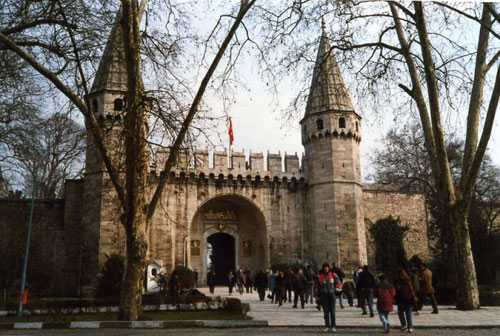Between the Golden Horn and the Marmara Sea, with an incredible view of the Bosforo, sits the Topkapi Palace . Built by order of the Sultan Mehmed II a few years after the final collapse of the Byzantium, it was the centre of administration for the Ottoman empire for the following four centuries – until 1853, and the Christian era, when the Sultan Abdulmecid decreed that the headquarters move to the modern Dolmabahçe Palace.
 topkapi istanbul
topkapi istanbul
Today, the Topkapi Palace is a museum dedicated to those far away glory years of the Ottoman Empire, and which houses some of the most magnificent treasures in the world. Visitors who wander the vast and winding spaces are often grateful for a tourist guide to show them the Pearl room for example, which holds the Topkapi head, embellished with precious stones, gold and emeralds – or the room which displays the famous Indio-Turkish throne from the 18th century.
But one thing we would advise you not to miss out on is the extraordinary collection of talismanic shirts, made famous recently thanks to the publication in Istanbul of Hülya Tezcan’s Las Camisas Mágicas del Palacio de Topkapi.
In Turkish culture, great importance has always been placed on magical practice – whether aesthetic or ritual – as a lesson for the future, from coffee, to the summoning of the omnipresent Turkish eye, or nazar to cast curses. Tezcan’s book speaks of the power of the talismanic tops to make the fighter invisible in battle, to protect from evil, to maintain good health and aid fertility. The latter was the case with the powerful Sultana Nurbanu – worried by the succession to the throne in the Somali house (which governed the Ottoman empire for 700 years) of her son, Murad III. At the time of coronation, Murad only had one son, and 14 years later – due allegedly to the magical garment, which was lined with verses from the Koran and various astrological signs, the sultan had produced 19 boys.
In Tuzcan’s opinion, with the restoration of many of the pieces, the clothes – which were worn by every member of the court – “allow us to evaluate to what extent the superstitions of the Ottoman court affected the politics of the empire.”
Paul Oilzum Only-apartments AuthorPaul Oilzum
The Sultan’s shirts required three years of work – and only at the end were chosen verses from the Koran inscribed. It’ll take you much less time to marvel over them when you rent apartments in Istanbul
via Topkapi Palace Istanbul.

Leave a Reply